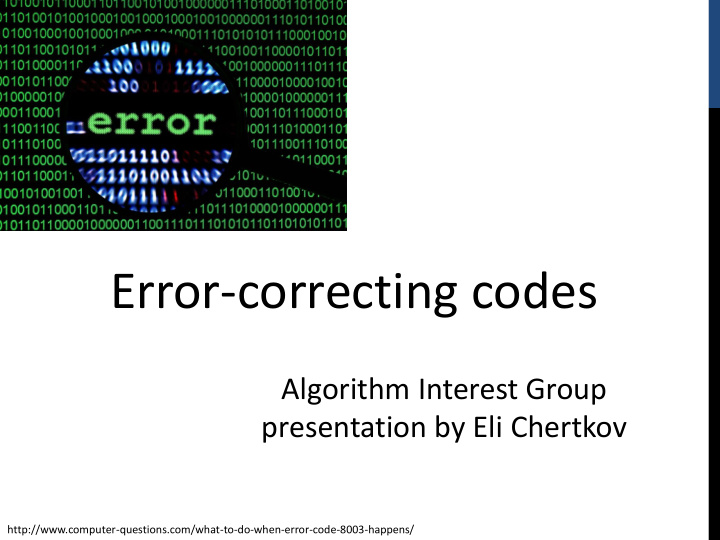



Error-correcting codes Algorithm Interest Group presentation by Eli Chertkov http://www.computer-questions.com/what-to-do-when-error-code-8003-happens/
Society needs to communicate over noisy communication channels https://en.wikipedia.org/wiki/Hard_disk_drive http://www.diffen.com/difference/Modem_vs_Router https://en.wikipedia.org/wiki/Cell_site https://www.nasa.gov/sites/default/files/tdrs_relay.jpg
Noisy bits We will visualize noise in data through random flipping of pixels in a black and white image. 𝑔 = probability of flipping a bit from 0 to 1 or vice versa 1 − 𝑔 = probability of a bit staying the same
Noisy channel coding To minimize the noise picked up by source data 𝒕 as it passes through a noisy channel, we can convert the data into a redundant signal 𝒖 .
Example: Repetition codes The simplest encoding one can think of is repetition coding 𝑆 𝑜 : repeat each bit 𝑜 times. 0101 → 𝑆 5 00000 11111 00000 11111 Encoding Noise from channel 01100 01101 00000 10001 The optimal decoding of a repetition code is to take the majority vote of each 𝑜 bits. 01100 01101 00000 10001 → 𝑆 5 0100 Decoding
Repetition code visualization A high probability of bit-error 𝑞 𝑐 in the transmitted data still exists. Easy to see and understand how it works, but not a useful code.
Example: Linear block codes A linear length 𝑂 block code adds redundancy to a length 𝐿 < 𝑂 sequence of source bits. 𝒖 𝒕 𝐿 𝐿 𝑂 − 𝐿 The extra 𝐿 − 𝑂 bits are called parity-check bits , which are linear combinations of the source bits mod 2. 0 (7,4) Hamming 1 1 code example 1 1 0 1 0 𝒖 = 𝑯 𝑈 𝒕 𝑯 𝑈 = 𝒖 = 1 𝒕 = 1 1 1 1 1 1 0 0 1 1 1 1 1 1 1
More about linear block codes Linear block codes are a large family of error-correcting codes, which include: Reed-Solomon codes, Hamming codes, Hadamard codes, Expander codes, Golay codes, Reed- Muller codes, … They differ by the linear transformation from 𝒕 to 𝒖 . 𝐿 𝑛𝑓𝑡𝑡𝑏𝑓 𝑡𝑗𝑨𝑓 The rate of a block code is 𝑆 = 𝑂 = 𝑐𝑚𝑝𝑑𝑙 𝑡𝑗𝑨𝑓 Decoding can become tricky for these codes, and is unique to the specific type of code used. Hamming codes, for instance, are nice because there is a simple and visual way, using Hamming distances, to optimally decode.
Linear block code visualization There is less redundancy in the error-coding ( 𝒕 → 𝒖 ) compared to repetition coding, but the probability of error scales the same as repetition coding 𝑞 𝑐 = 𝑃(𝑔 2 ) .
Shannon’s noisy -channel coding theorem In 1948, Claude Shannon showed that 1) there is a boundary between achievable and not achievable codes in the 𝑆, 𝑞 𝑐 plane and that 2) codes can exist where 𝑆 does not vanish when the error probability 𝑞 𝑐 goes to zero. Note: This does not mean that codes near the boundary can be efficiently decoded!
Sparse graph codes Transmitted bits 𝑯 𝑈 Parity-check bits (constraints) A low-density parity check code (or Gallager code) is a randomly generated linear block code represented by a sparse bipartite graph (sparse 𝑯 𝑈 ). Another example of a useful sparse graph code is a turbo code.
Belief Propagation Visible It is in general an NP-complete problem to decode low-density parity check codes. 𝑯 𝑈 However, a practically efficient Hidden approximate method exists, called Belief Propagation (BP) or the Sum-Product algorithm. It is a message passing algorithm that solves an inference problem on a probabilistic graphical model BP is a physics-inspired algorithm. It casts a probability distribution represented by a graph in terms of a Boltzmann distribution. Then it attempts to find the fixed point of the Free Energy under the Bethe approximation. It is exact for graphical models, which are trees. Details can wait for another talk…
References • Awesome resource (especially for physicists): Information Theory, Inference, and Learning Algorithms by David MacKay. (Basically the whole presentation is based off of the material in this book. )
References (continued) • Resource on Belief Propagation: Yedidia, J.S.; Freeman, W.T.; Weiss, Y., “Understanding Belief Propagation and Its Generalizations”, Exploring Artificial Intelligence in the New Millennium (2003) Chap. 8, pp. 239-269.
Recommend
More recommend